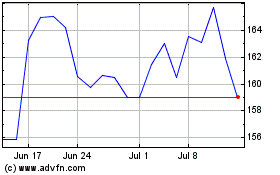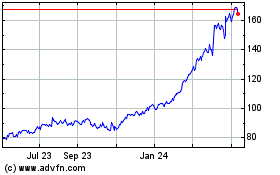NTSB: Uncontained Engine Failure Caused British Air 777 Fire
October 06 2015 - 4:40PM
Dow Jones News
General Electric Co. said it is inspecting certain GE90 jet
engines after accident investigators determined that the fracture
of a high-pressure compressor part caused a serious runway fire
aboard a British Airways PLC aircraft last month.
The U.S. National Transportation Safety Board on Tuesday
identified that the break originated deep inside the engine, and
said the engine maker is "performing high-priority, focused
inspections" of other GE90 engines to help investigators determine
further actions.
In a statement, the safety board confirmed earlier preliminary
findings that parts of the Boeing Co. 777's left engine shot
outside the casing, a rare and dangerous event that modern
jet-engine designs are intended to prevent.
The NTSB said the problem originated in a portion of the
high-pressure compressor, the section that squeezes the air flowing
through the engine core before it is mixed with fuel and
combusted.
Flight 2276, British Airways' scheduled service from McCarran
International Airport in Las Vegas to London Gatwick, suffered the
engine failure as it accelerated for takeoff on the runway. The
roll was quickly aborted by the pilots and the burning jet was
evacuated.
The NTSB previously said only minor injuries were suffered by
the 157 passengers and 13 crew members during the evacuation,
though the plane was extensively damaged.
So-called uncontained failures, in which internal parts break
through the engine's protective casing, can badly damage planes
because the parts can hit wings, fuel tanks and fuselage.
The events are so rare that they prompt stepped-up investigative
scrutiny. General Electric previously said it was the first such
incident on a GE90 engine since its introduction to service 20
years ago.
General Electric said the part at issue is about 20 years old.
Spokesman Rick Kennedy said the company is currently inspecting
about three dozen other engines of similar vintage to determine any
patterns of wear or other problems "to help us define" whether a
broader inspection program was necessary. GE said there are about
400 of its older-generation GE90 engines currently in service. The
company added that newer, more-powerful GE90 variants aren't
subject to the current investigation.
Write to Andy Pasztor at andy.pasztor@wsj.com
Subscribe to WSJ: http://online.wsj.com?mod=djnwires
(END) Dow Jones Newswires
October 06, 2015 16:25 ET (20:25 GMT)
Copyright (c) 2015 Dow Jones & Company, Inc.
GE Aerospace (NYSE:GE)
Historical Stock Chart
From Mar 2024 to Apr 2024

GE Aerospace (NYSE:GE)
Historical Stock Chart
From Apr 2023 to Apr 2024
